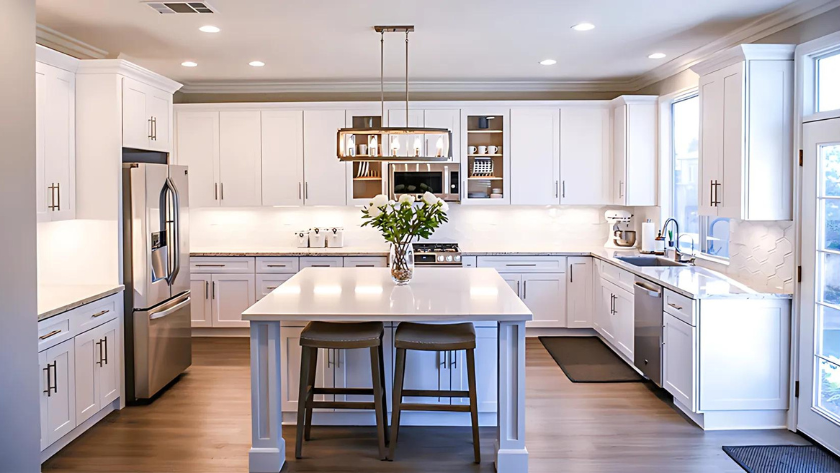Layered Lighting Design Guide

When creating a lighting design plan for residential or commercial areas, a layered lighting plan enables the space to be used for multiple application purposes, and can help to add sophistication. The main layers that should be considered in any lighting plan are ambient lighting, task lighting, and accent lighting.
General Ambient Lighting
Ambient lighting provides widespread illumination for day-to-day activities. To achieve ambient lighting in residential spaces, basic ceiling light fixtures such as downlights, flush mounts, and batten fix lights can be used.

Recessed downlights with a wide beam angle are perfect for general lighting throughout the home. In rooms where comfort is desired, such as living rooms and bedrooms, select lighting with a warm white colour temperature of 2700K or 3000K. In spaces where task work is to be done, such as study rooms, kitchens, and bathrooms, select lighting with a cool white (4000K) or daylight (6000K) colour temperature.
For a softer ambient light, floor lamps are ideal for use in living rooms and bedrooms. In these spaces, floor lamps can provide a soft glow for relaxation in the evening in place of harsh overhead lighting.
Decorative Ambient Lighting
Decorative lighting provides just enough brightness in a room while adding a sense of style and flare.

One type of decorative fitting is pendant lighting. A pendant light is a singular light fixture that is suspended from the ceiling by a cord, chain, or metal rod. Install a singular pendant over a square or round dining table for ambient lighting during dinner time. For a long rectangular dining table, install a series of pendants in a linear formation.
Pendants can also be installed on either side of a bed in the bedroom, over the bedside tables. This ensures adequate lighting for reading before bed.
To make a statement with your ambient lighting, go for a chandelier light. These fittings use crystals and glass to refract the light in all directions, creating a unique lighting effect.
Task Lighting
To improve focus and visual clarity when working, task lighting is essential as it directly illuminates work surfaces.

Table lamps can be used in the study or home office to optimise reading and writing tasks. Use pendant lighting over a kitchen bench top to optimise visual clarity when preparing meals and chopping vegetables. Cool white or daylight colour temperatures are ideal for these tasks, however bare in mind that open plan areas should have one kelvin colour throughout.
Recessed downlights are ideal for task lighting as they can be purchased with a mid beam angle of 35 - 60 degrees. The beam is designed to land directly on working surfaces to avoid the line of sight and to reduce glare.
Accent Lighting
Accent lighting can be used to highlight specific features such as photography, artwork, statement furniture, or architectural details. Make sure accent lights are 3 times brighter than the surrounding ambient light in order to achieve the desired effect.

Gimbal or tilt downlights can be used to direct a spotlight towards statement furniture. Wall washing downlights can also be installed close to the wall to highlight artworks or photography. Beam angles of 24 degrees or less are normally required.
This can also be achieved by using track lighting. Use multiple spotlights on a track and direct each light towards different architectural features in the room.
Wall lights add an interesting design feature in halls, living rooms or bedrooms. Wall, ceiling and recessed floor lights add the additional decorative effect of highlighting textured surfaces such as brick or stone walls.
Final Considerations
When installing multiple pendants, chandeliers, lamps, and wall brackets in the same space, you may want to keep the materials or colours consistent to achieve a uniform look and feel. This may include matching the type of metals used, or matching the colour temperature of the light.

When installing layered lighting in commercial areas such as restaurants, office lighting, or hotels, a DALI hub can be used to maximise lighting control. The DALI system enables you to dim a specific layer to suit the desired application. For example, to transition from the day time to a relaxing evening atmosphere in a hotel setting, the DALI system dims lights accordingly. Alternatively, you can create “scenes” to turn off a specific set of lights at this time, such as turning off general ambient lighting and leaving the decorative lighting on.




